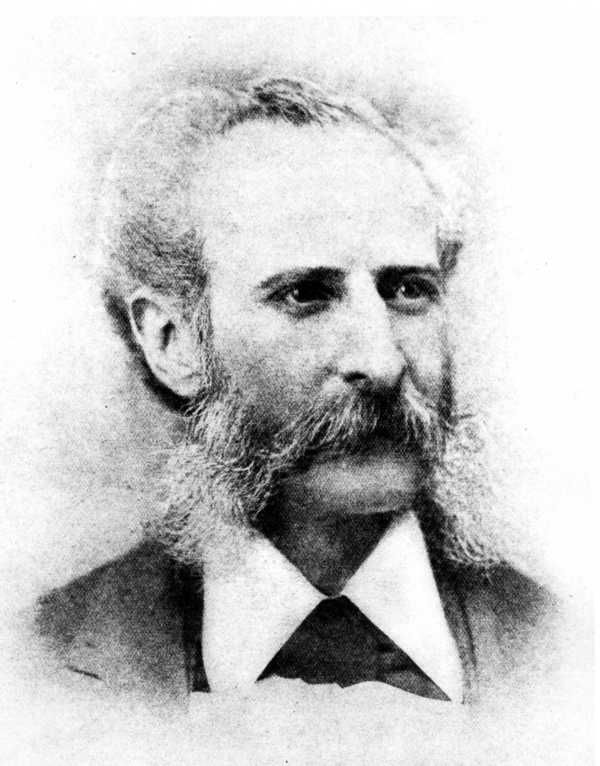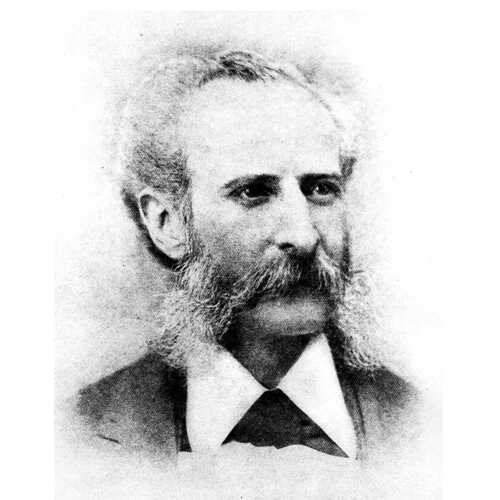
Source: Link
MOHR, SIGISMUND, engineer; b. 21 Oct. 1827 in Breslau, Prussia (Wrocław, Poland), son of Herman Mohr; m. c. 1856 Blume Levi, daughter of Philip Levi of New York, and they had at least five daughters (Philippine, Amelia, Lenorah, Fanny, and Clara) and two sons (Eugene Phillip and Henry Ralph); d. 15 Dec. 1893 at Quebec.
Nothing is known about Sigismund Mohr’s early years except that he reputedly graduated as an electrical engineer from the college in Breslau in 1849. He is believed to have spent a few years in London before immigrating to Canada and taking up residence at Quebec around 1871. From 1873 the Quebec directory listed a Mme “Sighmond” Mohr, who specialized in the sale of “ladies under clothing,” and Amelia and E. P. Mohr (doubtless Eugene Phillip).
Sigismund seems to have had problems from the start. In September 1875 he was under court orders to pay $100.40 for products purchased in August and September 1874 from John Kerry, David Watson, and Walter B. King of Montreal, partners in a wholesale pharmaceutical business. Mohr was ordered to pay $412.44 to Lévis merchant Antoine Carrier on 13 Sept. 1877 and on 18 Dec. 1879 much of his furniture was confiscated for failure to pay the rent for his living quarters on Rue Saint-Jean. On 25 Feb. 1880 his attorneys, Gauthier and Chouinard, argued that the premises were insalubrious and had been so declared by “the City Inspector, who, after examining the aforesaid house, condemned it as uninhabitable and ordered the defendant and his family to move out at once.” The Mohr family had, however, lived in the place for a full year, until 1 May 1879. The lease, signed on 26 April 1878, called for an annual rent of “120 piastres.”
At the time of the 1877 trial Mohr had been described as a “telegraph agent.” Indeed on 5 Oct. 1876 the Quebec City Council had passed a motion “recommending that exclusive priviledge be granted Mr Mohr for seven years to establish & work the proposed telegraph in this City provided it in no way intervenes with the fire alarm telegraph.” On 9 October the authorities of the Séminaire de Québec decided “to rent one of Mohr’s devices for private telegraphy.” The following day he registered the City District Telegraph Company, which he had formed in partnership with William B. Chapman and Henry Harris, who at some point married one of his daughters.
The introduction of the telephone, which Mohr began promoting at Quebec, provoked keen competition. The Canadian District Telegraph Company of Montreal obtained province-wide distribution rights for the telephone developed by Alexander Graham Bell*. The Montreal Telegraph Company enjoyed great success with Thomas Alva Edison’s telephonic invention, in particular with a Montreal–Quebec line that was tried out at Quebec in 1877. The journal of the Séminaire de Québec for 2 October of that year mentions that Mohr was “to put on, in a few days, a telephony demonstration (speaking from a distance by telegraph wire) between M. [Arthur] Lavigne’s store and our priests’ recreation room.” The experiment was successfully carried out on 9 October. About the same time, Cyrille Duquet*, a goldsmith, jeweller, and inventor, began installing his own telephones. On 14 May 1879 the city authorities of Quebec gave him permission to “erect a line of telephone from his store in Fabrique St. to the Jesus Marie convent at Sillery.”
After trying to sell his invention to Canadian interests for $100,000, Bell accepted an offer in March 1880 from National Bell Telephone of Boston, which hastily set up a Canadian company. In July the Bell Telephone Company of Canada bought the Dominion Telegraph Company, including its factory and rights. A letter was promptly sent to the latter’s 35 Canadian agents – 28 in Ontario, 3 in Nova Scotia, 2 in New Brunswick, and 2 in Quebec. Mohr had dissolved the City District Telegraph Company in January 1878 and was by then in the employ of the Dominion Telegraph Company at Quebec. Thus he became an agent for the Bell Telephone Company of Canada.
Since 21 Feb. 1880 one telephone centre at Quebec had been serving the 36 subscribers of the Dominion Telegraph Company. In the fall of that year the Bell purchased the Montreal Telegraph Company and its subsidiaries, which had begun setting up their own telephone centres. It undertook to keep the telephone and telegraph services separate and to integrate the two telephone networks wherever they were both in operation. At Quebec, this task fell to Mohr, who carried it out successfully. In fact, he increased the number of subscribers from 79 to 240 in six months.
Mohr encountered more difficulties, however, when it came to installing his poles. On numerous occasions he had to go back to city council and in the end he was taken to court by James Carrell, the owner of the Daily Telegraph. A complex legal battle ensued and various governments became involved, in regard to connections that were interprovincial or international. Mohr was constantly at the centre of the controversy with his poles, which irritated many taxpayers. He nevertheless gained stature in the eyes of his employers, who readily granted him the raise in salary he asked for in 1882.
That year Mohr was back in court again, this time as a witness in a lawsuit between the Canadian Telephone Company (Bell) and Cyrille Duquet. Giving his age as 55, he was sworn in on the Bible on 11 May and stated that he had been an agent of the company since it first began operating at Quebec. He testified that telephones manufactured by Duquet were installed at Quebec and leased on an annual basis for a price that varied according to distance. At the conclusion of this important trial, Duquet was fined a small sum for using a technique patented by Bell, but he sold the Canadian Telephone Company a receiver he had developed and had patented on 1 Feb. 1878.
No sooner was the trial over than Mohr obtained permission to install a telephone cable between Quebec and Lévis on condition that he find ten enterprises willing to subscribe $100 a year. This objective was reached in August 1882. In December 1883 Mohr was succeeded by W. Duchesneau, but he still remained in contact with the company, which consulted him on at least two occasions. His interest now turned towards other applications of electricity, however, and it was as an electrician that he was listed in the 1883 city directory.
Mohr became a real hero on the evening of 29 Sept. 1885. According to the next day’s issue of Le Canadien, “The great electric light exhibition, so impatiently awaited, took place last night on Terrasse Dufferin, with a success that drew the applause of 20,000 people.” The reporter did not hide his enthusiasm for “M. Mohr, the active and intelligent manager [of the] Compagnie de Lumière Électrique de Québec et Lévis [which] has succeeded beyond all expectations” in transporting the “fluid” produced by Montmorency Falls to the “34 centres of light” set up on the terrace. On a signal given by Lieutenant Governor Louis-François-Rodrigue Masson* “by means of an electric bell [the] appearance of the terrace was transformed as if by a magic wand.”
For a week Mohr would repeat his feat of transporting the “fluid” over a distance of 34 miles. After two highly satisfactory days, he made his demonstration more complicated by cutting off the current and restoring it an instant later. The crowd went wild. The populace demanded electricity. Petitions were circulated. The only difficulty was that the gas company had seen what was coming and had signed a seven-year contract with the city. But electric lights were installed anyway, at first “in the districts lit by coal-oil.”
Once again Mohr found Duquet’s path crossing his. Duquet had prepared for the authorities a careful assessment of the city’s requirements in terms of lighting and of the costs involved. From 1886 to 1889 Mohr completed a network of electric lighting in his capacity as manager of the electric light company. In 1889 the minutes of the city streets committee, with which Mohr usually dealt, contained a proposal to light the city hall itself.
In November 1893 a storm damaged the power-line linking Quebec and Montmorency Falls. Despite the bad weather Mohr set to work repairing the damage. He caught a serious case of influenza, which rapidly became worse and brought about his death on Friday, 15 December, at 4:00 a.m. All the Quebec newspapers prominently reported his death, especially the Daily Telegraph, which noted that the body would be taken to New York the following Monday for burial among other members of his family. He left a widow and six children. The paper indicated that his two sons held important positions in the United States, Eugene Phillip apparently being the head of the company that ran the telephone and electricity utilities in Brooklyn.
Sigismund Mohr managed to combine his technical knowledge with unfailing enthusiasm. Like Cyrille Duquet and other inventive minds of his time, he was able to move on from the telegraph to the telephone and then to electricity. No doubt because of his perseverance and fierce determination, his modest beginnings were soon forgotten, along with the controversies over the installation of poles in the narrow streets of Quebec. An unrecognized pioneer, a figure neglected in general historical works, this modest Jewish immigrant helped to transform the face of Quebec in the late 19th century.
[Little is said in general historical works about the early development of the telephone and of electricity, and even specialized monographs barely mention pioneers such as Sigismund Mohr.
In “Le téléphone à Québec,” BRH, 45 (1939): 157–58, Sigismund Mohr is incorrectly identified as E.-P. Mohr. d.v.]
ANQ-Q, E25/425; M80; M87; T11–1/28, nos.1903, 2010, 2125; T11–1/184, no.124; 882, no.1411; 946, no.1544; 1064, no.1823; 1085, no.1947. ASQ, Journal du séminaire, II: 665; Plumitif du conseil, 9 oct. 1876. AVQ, Travaux publics, comité des chemins, procès-verbaux, nos.8–10. Bell Canada, Information Resource Centre, Telephone Hist. Coll. (Montreal), Letters to Sigismund Mohr; “Sigismund Mohr and the telephone in Quebec City” (20 Nov. 1959); “Sigismund Mohr and the Bell Telephone Company” (n.d.). Hydro-Québec, Centre d’arch. (Montréal), Imperial Electric Light Company (F0074); Quebec and Levis Electric Light Company (F0259). R. v. Mohr, Rapports judiciaires de Québec (Québec), 7 (1881): 183–92. Le Canadien, 16 oct. 1877; 29 sept. –2 oct. 1885. Le Courrier du Canada, 16 déc. 1893. L’Électeur, 15 déc. 1893. Morning Chronicle (Quebec), 10 Oct. 1877, 9 Feb. 1878, 3 Nov. 1879, 28 Feb. 1880, 16 Dec. 1893. Quebec Daily Mercury, 15 Dec. 1893. Quebec Daily Telegraph, 28 Sept. 1877, 9 Feb. 1878, 29 Jan. 1880, 15 Dec. 1893. Quebec directory, 1873–94. The Jew in Canada: a complete record of Canadian Jewry from the days of the French régime to the present time, ed. A. D. Hart (Toronto and Montreal, 1926), 427. Brantford Expositor (Brantford, Ont.), 28 Nov. 1959. Jewish Standard (Toronto), 1 Sept. 1959. “Les 60 ans du téléphone,” L’Événement-Journal (Québec), 27 avril 1940: 4. Telephone Gazette (Montreal), 1 (1909), no.4: 1–4.
Cite This Article
Denis Vaugeois, “MOHR, SIGISMUND,” in Dictionary of Canadian Biography, vol. 12, University of Toronto/Université Laval, 2003–, accessed December 19, 2025, https://www.biographi.ca/en/bio/mohr_sigismund_12E.html.
The citation above shows the format for footnotes and endnotes according to the Chicago manual of style (16th edition). Information to be used in other citation formats:
| Permalink: | https://www.biographi.ca/en/bio/mohr_sigismund_12E.html |
| Author of Article: | Denis Vaugeois |
| Title of Article: | MOHR, SIGISMUND |
| Publication Name: | Dictionary of Canadian Biography, vol. 12 |
| Publisher: | University of Toronto/Université Laval |
| Year of publication: | 1990 |
| Year of revision: | 1990 |
| Access Date: | December 19, 2025 |



